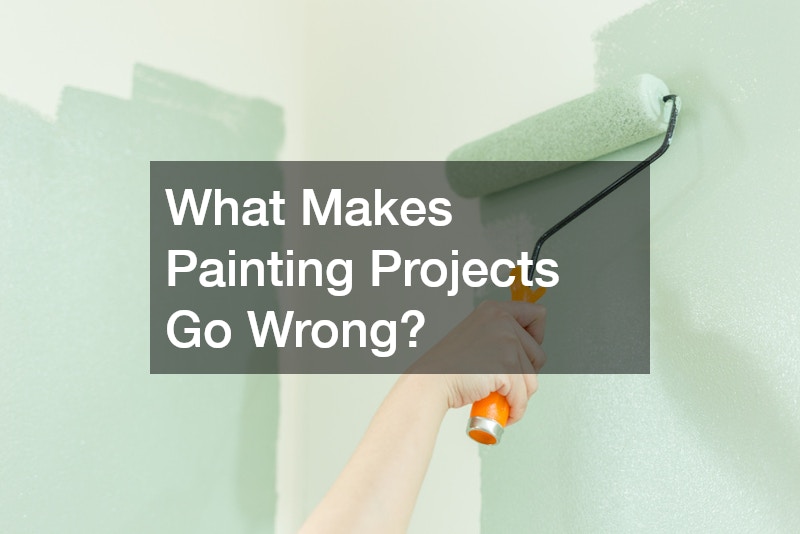Home improvement projects can be exciting and rewarding, allowing homeowners to put a personal stamp on their living spaces while saving money. However, even well-intentioned DIY efforts can quickly turn into costly mistakes. Many homeowners underestimate the complexity of projects, overlook safety protocols, or choose inappropriate materials, resulting in issues that may take months or even years to resolve. From plumbing disasters to faulty electrical work and improper roofing, the consequences of DIY errors can compromise both safety and property value, making careful planning essential when creating home improvements.
Why Do DIY Projects Often Fail?
DIY projects fail for many reasons, often because homeowners overlook critical steps in planning and execution. Some common causes include misjudging the complexity of a task, lacking the proper tools, and underestimating the time and resources required. Choosing low-quality materials or skipping research can also have serious repercussions. A minor mistake in one part of a project, such as poor adhesive application or uneven leveling, can cascade into larger problems, requiring costly repairs.
Misjudging Project Complexity
Many DIY enthusiasts start projects with confidence but quickly realize they misjudged the difficulty. Tasks like roof installations or mold removal require specialized knowledge and experience. Attempting these projects without adequate skills can lead to structural damage or health hazards. Even simpler tasks, like artificial lawn installation or tree removal, may require professional insight to avoid soil erosion, drainage problems, or injury.
Lack Of Proper Tools
Using the wrong tools, or no tools at all, is a frequent cause of DIY failure. For example, a local concrete company will emphasise the need for precise mixing and leveling equipment when pouring concrete. Similarly, improper tools during AC repair or electrical work can compromise performance and safety. Investing in or renting the correct tools is critical to avoiding mistakes that could later cost far more than professional services.
Inadequate Planning
Planning is the backbone of successful DIY projects. Without it, homeowners risk running out of materials, encountering unforeseen obstacles, or creating structural issues. Poor planning in projects like insulation installation or roof repair can result in energy inefficiency, leaks, or compromised home integrity. Taking the time to map out each step, source high-quality materials, and account for potential challenges is essential.
Underestimating Time Required
Time is another critical factor. Many DIY enthusiasts underestimate how long a project will take, leading to rushed work or incomplete installations. Roof installations, gutter replacements, or even simple painting projects often take longer than anticipated. Rushing can increase the likelihood of errors, reduce quality, and create long-term problems that require professional intervention.
Poor Quality Materials
Using substandard materials may seem cost-effective initially, but it often leads to costly repairs. For instance, inexpensive insulation may degrade faster, while low-quality roofing materials can fail under harsh weather. Investing in quality materials and sourcing them from reputable suppliers is crucial. This principle also applies to plumbing, electrical components, and artificial lawn installation, where material durability directly affects long-term performance.
How to Identify and Avoid Common DIY Mistakes?

Avoiding DIY disasters starts with awareness. Homeowners can mitigate risk by conducting thorough research, seeking expert advice, and prioritizing safety. Even with simple projects, failing to plan for emergencies or skipping safety protocols can result in injury or property damage.
Conducting Thorough Research
Before starting any project, research is essential. Understanding the requirements, steps, and potential pitfalls of tasks like mold removal, roof repair, or gutter installations can prevent costly mistakes. Research includes reading tutorials, watching demonstration videos, and consulting product instructions. Knowing what to expect helps avoid common issues and ensures smoother project execution.
Learning From Expert Advice
Professional advice is invaluable. Hiring electricians or an insulation contractor for consultation, even for smaller projects, can save time and prevent costly errors. Expert insights can reveal hidden risks in projects like AC repair, local concrete pours, or artificial lawn installation, allowing homeowners to address them proactively.
Creating a Structural Plan
A structural plan ensures that projects do not compromise the home’s integrity. For example, incorrect tree removal can damage foundations or underground utilities, while poorly executed roof installations can lead to leaks or weakened support. Mapping out the project’s steps, measuring carefully, and understanding load distribution are crucial for safety and longevity.
Having An Emergency Plan
DIY projects often involve unexpected challenges. Having an emergency plan, such as knowing who to call for a sudden mold outbreak or electrical issue, is vital. This preparedness reduces stress and ensures that minor mistakes do not escalate into major disasters.
Prioritizing Safety First
Safety should never be compromised. Protective gear, proper ventilation, and adherence to building codes are essential. This is particularly important in projects involving electricity, heavy machinery, or roof work. Neglecting safety can result in injuries, property damage, and legal complications.
What Are the Consequences of Incorrect Plumbing?
Plumbing errors are among the most damaging DIY mistakes. Even small mistakes, such as loose fittings or incorrect pipe angles, can escalate into significant problems that affect the entire home.
Water Damage Issues
Leaks or pipe bursts can cause severe water damage to walls, floors, and ceilings. Water intrusion often leads to expensive repairs and can compromise structural integrity. Professional guidance from licensed plumbers or an informed DIY approach can prevent these scenarios.
Mold and Mildew Growth
Persistent moisture from faulty plumbing promotes mold and mildew growth, creating health hazards and necessitating mold removal. Exposure to mold can trigger allergic reactions and respiratory issues, highlighting the importance of accurate installation and maintenance.
Increased Water Bills
Leaks that go unnoticed or untreated increase water bills over time. Even small drips from improper AC repair, faulty faucets, or misaligned pipes can have a cumulative financial impact.
Compromised Water Pressure
Incorrect plumbing can reduce water pressure, making daily tasks frustrating and inefficient. This issue often arises from poorly connected pipes, obstructions, or improper pipe sizing.
Pipe Burst Risks
The most severe consequence is a burst pipe, which can flood homes and damage expensive equipment and personal belongings. Preventing this risk requires attention to detail and sometimes professional intervention.
How Do Electrical Missteps Create Home Hazards?

Electrical errors are a major concern for DIY enthusiasts. Faulty wiring or improper installations can lead to serious hazards, including fire and electrocution.
Fire Hazards
Incorrect wiring or overloaded circuits can spark fires. Many homes experience electrical fires due to DIY mistakes, emphasizing the importance of consulting licensed electricians or adhering strictly to electrical codes.
Power Outages
Faulty installations may cause frequent power outages, affecting appliances, lighting, and essential systems. Even minor mistakes during projects like AC repair or lighting upgrades can result in repeated outages.
Damaged Appliances
Improper electrical work can fry appliances, requiring costly replacements. Simple errors, such as incorrect outlet wiring, can destroy sensitive electronics and household equipment.
Electrocution Risks
Electrocution is a severe risk in DIY electrical work. Failure to disconnect power, use insulated tools, or follow safety procedures can result in serious injury or even death.
Compliance Issues With Building Codes
Noncompliance with electrical codes may complicate home sales or insurance claims. Building inspectors and insurance companies often identify DIY mistakes that violate safety regulations, leading to expensive remediation.
What Flooring DIY Errors Should Be Avoided?
Flooring projects may appear straightforward, but they are deceptively tricky. Mistakes in measurement, leveling, or material selection can affect both appearance and structural integrity.
Leveling Mistakes
Uneven subfloors lead to warped surfaces and squeaky floors. Accurate leveling is essential, especially when installing heavy materials like tiles, stone, or concrete from a local concrete company.
Incorrect Measurements
Even small miscalculations can result in wasted materials or ill-fitting flooring pieces. Precision is vital for ensuring seamless installations and maintaining structural alignment.
Poor Adhesive Application
Improper adhesive use can cause tiles or planks to lift over time, creating safety hazards. Each flooring type has specific adhesive requirements that must be followed.
Expansion and Contraction Misjudgments
Materials like wood expand and contract with temperature and humidity changes. Failure to account for these shifts can cause buckling, gaps, or cracking, undermining the project’s longevity.
Incompatible Materials For Climate
Selecting flooring materials that are unsuitable for the local climate can accelerate wear and tear. For example, wood flooring in damp areas can warp, while certain synthetic options may degrade under UV exposure.
What Makes Painting Projects Go Wrong?

Painting is one of the most common DIY undertakings, yet errors often result in uneven coverage, peeling, or premature fading.
Poor Surface Preparation
Skipping proper surface cleaning or sanding leads to paint that fails to adhere correctly. Walls with dust, grease, or old paint require thorough preparation for a durable finish.
Using Incorrect Paint Type
Selecting the wrong type of paint for a surface or environment can compromise durability. For instance, exterior surfaces need weather-resistant formulations, while indoor paints must suit humidity and wear conditions.
Ignoring Humidity and Temperature
Painting in inappropriate weather conditions affects drying and curing times, potentially causing streaks, bubbling, or cracking.
Improper Application Techniques
Uneven brush or roller strokes, inconsistent pressure, and insufficient layering can produce unsightly finishes. Proper technique is essential to achieving professional-looking results.
Skipping Primer
Primer is crucial for adhesion, especially on new surfaces or drastic color changes. Skipping it often leads to premature peeling or uneven coloration.
Why Are Roofing DIYs So Risky?
Roofing is among the most challenging and dangerous DIY projects. Mistakes in this area can compromise home safety and lead to expensive repairs.
Improper Installation Techniques
Incorrect shingle placement or fastener use can cause leaks and reduce roof lifespan. Roof installations require precise alignment and attention to manufacturer guidelines.
Roof Leaks And Water Damage
Even minor gaps can allow water infiltration, damaging insulation, ceilings, and structural components. Prompt professional roof repair is often necessary to mitigate long-term damage.
Inadequate Ventilation
Improper ventilation can trap moisture, accelerate mold growth, and reduce energy efficiency. Homes with poor attic airflow face higher risks of structural and health issues.
Poor Weatherproofing
Neglecting sealants, flashing, or underlayment reduces protection against rain, snow, and wind. Weatherproofing is a critical component of any roof installation.
Safety Risks
Roofing presents significant fall hazards. Without proper safety equipment and training, DIY roof work can result in serious injury or death.
How Does Landscaping Impact Home Stability?

Landscaping may seem purely aesthetic, but poor planning can affect the home’s structural integrity and safety.
Improper Grading And Drainage
Incorrect grading can direct water toward foundations, leading to flooding or structural weakening. Proper grading and drainage planning are essential for long-term home protection.
Root Damage To Foundations
Tree roots can infiltrate and damage foundations, plumbing, and underground utilities. Hiring experienced tree removal companies can prevent costly structural problems.
Poor Irrigation Planning
Excessive watering or inefficient irrigation systems can cause soil erosion or waterlogging. Planning irrigation carefully protects plants while preserving home stability.
Planting Invasive Species
Certain plants and trees can spread aggressively, damaging landscaping, foundations, and pipes. Awareness of species compatibility with your area is crucial.
Ignoring Local Climate Conditions
Ignoring the local climate may result in failed plantings or soil issues, affecting both aesthetics and property safety. Proper selection ensures sustainable and resilient landscaping.
What Are the Pitfalls in Remodeling Kitchens and Bathrooms?
Kitchen and bathroom renovations are highly complex, involving plumbing, electrical work, and precise design. DIY mistakes in these spaces can be particularly costly.
Ignoring Workflow Efficiency
Inefficient layouts reduce usability and comfort. Proper planning ensures a smooth workflow between sinks, appliances, and work surfaces.
Overlooking Storage Needs
Inadequate storage compromises functionality. Planning cabinets, shelving, and counter space carefully is essential for long-term satisfaction.
Poor Ventilation Choices
Bathrooms require proper ventilation to prevent moisture buildup, which can lead to mold and mildew. In kitchens, ventilation is critical to managing heat and cooking odors.
Waterproofing Failures
Incorrect waterproofing around showers, sinks, or flooring can result in leaks and structural damage. Hiring professionals or following precise DIY protocols prevents future headaches.
Budget Overruns
DIY projects often exceed planned costs due to errors, delays, or underestimated material requirements. Accurate budgeting and contingency planning are vital to avoid financial strain.
How Can Inaccurate Measurements Lead to DIY Failures?
Accurate measurements are critical to any home improvement project. Errors can cause misaligned installations, wasted resources, and safety hazards.
Ill-Fitting Fixtures And Furniture
Miscalculated dimensions result in appliances, cabinets, or furniture that do not fit, necessitating costly adjustments or replacements.
Structural Integrity Compromises
Improperly sized beams, joists, or flooring components may weaken structures. Even minor miscalculations can create serious long-term risks.
Wasted Materials And Resources
Inaccurate measurements lead to wasted materials, including paint, wood, or tiles, inflating project costs unnecessarily.
Difficulty In Project Adjustments
Fixing measurement errors often disrupts project flow, requiring additional labor and complicating timelines.
Effect On Nearby Installations
Measurement mistakes can negatively impact other installations. For example, poorly measured flooring may conflict with plumbing, electrical outlets, or insulation installations by an insulation contractor.
DIY home improvement projects can be satisfying and cost-effective, but they come with inherent risks. From plumbing errors and electrical missteps to roofing disasters and landscaping miscalculations, the consequences of DIY mistakes can be severe. Engaging with gutter companies, electricians, local concrete companies, or tree removal companies when necessary can prevent long-term damage. Proper planning, accurate measurements, quality materials, and prioritizing safety are essential to successful DIY efforts. By learning from experts, researching thoroughly, and preparing for emergencies, homeowners can avoid unexpected issues and ensure their improvements enhance, rather than compromise, the integrity and value of their homes. Thoughtful, careful approaches to projects like AC repair, roof repair, artificial lawn installation, mold removal, and insulation installation can make all the difference, creating spaces that are functional, safe, and visually appealing.





